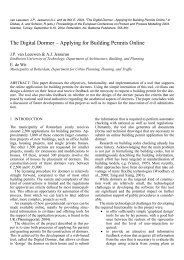ecppm 2002 - Jos P. van Leeuwen
ecppm 2002 - Jos P. van Leeuwen
ecppm 2002 - Jos P. van Leeuwen
Create successful ePaper yourself
Turn your PDF publications into a flip-book with our unique Google optimized e-Paper software.
To find the candidates, the procedure illustrated<br />
in Figure 2 is followed:<br />
1 Inspect the instance’s all components.<br />
2 Collect the types of all component fillers (2.1) as<br />
well as the fillers’ supertypes (2.2).<br />
3 For each type t from step 2, collect the types<br />
where t is a component. The result is the list of<br />
candidate types.<br />
4 For each of the types from 3, add the subtypes to<br />
the candidate list.<br />
A component will have one or more fillers, i.e.<br />
feature instances that represent a part or a property<br />
of the main feature instance. To be a candidate, a<br />
type must primarily have a component in common<br />
with the instance, i.e. the components should have<br />
identical names and role types. Secondly, the types<br />
of the fillers of the components must match. If both<br />
of these criteria match, the type is added to the candidate<br />
list.<br />
The second criterion might introduce an element<br />
of recursion, since the correct types of the instance’s<br />
fillers need to be known before the evaluation can be<br />
made. Currently, however, no typing of the fillers is<br />
done. The main reason for this is that currently the<br />
user needs to make the final selection of the type,<br />
and it would be too confusing to repetitively have to<br />
select the type of subcomponents. To be efficient,<br />
recursion needs automatic type selection.<br />
To aid the user, the candidate list is ordered according<br />
to applicability. The ordering is based on<br />
several criteria, such as:<br />
4<br />
Instance for<br />
recognition<br />
FTR candidates<br />
Supertype<br />
Types<br />
Subtypes<br />
Component<br />
Inherited component<br />
Component instance<br />
1<br />
3<br />
Supertypes<br />
Supertype<br />
recognizedType<br />
instantiatedType<br />
Instance's<br />
type<br />
Instances<br />
Figure 2 The algorithm for finding feature type candidates.<br />
Legend: Rectangles represent feature types and instances. Thin<br />
straight arrows represent relations defined by FBM. Thick arrows<br />
represent how the FTR process traverses the feature data.<br />
1. How well does the candidate’s set of components<br />
match the actual components of the instance?<br />
2.2<br />
2.1<br />
2. How well do the candidate’s components<br />
match the instance’s component fillers?<br />
For criterion 1, there might be an exact match of<br />
components between the candidate type and the instance,<br />
or the type may have more or less components<br />
than the instance. In case a type has components<br />
that the instance lacks, the type represents a<br />
specialisation of the instance. Choosing such a type<br />
implies adding the missing components to the instance,<br />
and thus adds information to the model.<br />
The problem of how to automatically select types<br />
is studied in the second year of the research project<br />
(<strong>2002</strong>), and the subject is not ready for conclusions<br />
at the time of writing. Nevertheless, it can be said<br />
that the outcome of an automatic FTR process depends<br />
on what weights are given to the different<br />
matching criteria, and the problem consists of determining<br />
what impact different weights will have.<br />
Plausibly, different settings would be preferable for<br />
different purposes. What is already clear is that an<br />
automatic FTR process should not add information<br />
to a model. Thus, an automatic process will not consider<br />
candidates that by the manual selection might<br />
be presented to the user as suggestions to further<br />
specify the design model.<br />
6 STANDARDS FOR PRODUCT<br />
INFORMATION<br />
To allow product information searches, standards<br />
need to be developed for the purpose. We have studied<br />
two standards that are rele<strong>van</strong>t in the context of<br />
building product information.<br />
6.1 PLIB – ISO 13584<br />
The ISO 13584 standard, called PLIB, is a standard<br />
for parts libraries, i.e. catalogues that organise information<br />
about standard components. This section<br />
makes a brief presentation of the PLIB standard. The<br />
information on PLIB was obtained from (Pierra<br />
1997) and (Pierra et al 2000).<br />
A PLIB parts library consists of two parts:<br />
− a classification tree where component families<br />
and technical properties are identified and connected;<br />
− a set of templates that describe successively each<br />
component family and each technical property.<br />
Thus, the technical properties are closely connected<br />
to the component families, and vice versa.<br />
The close connection seems to make it difficult to<br />
define generic properties that are common for many<br />
otherwise dissimilar products. The following quotation<br />
confirms this: “Unfortunately, the world is not a<br />
tree, and it is impossible to associate properties to<br />
the class hierarchy in such a way that every common




